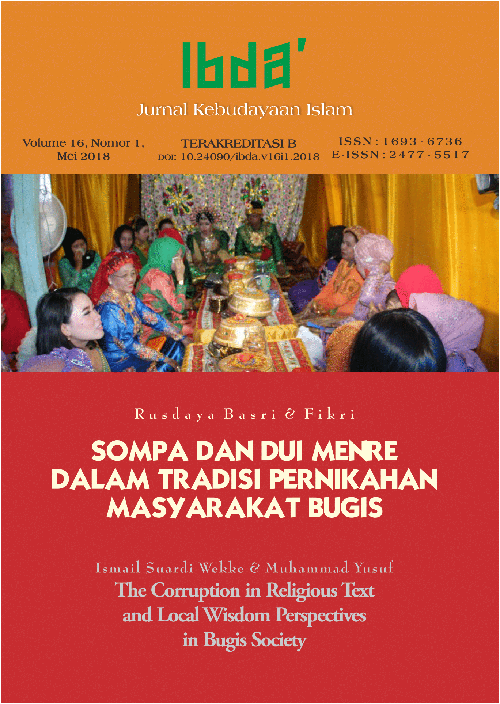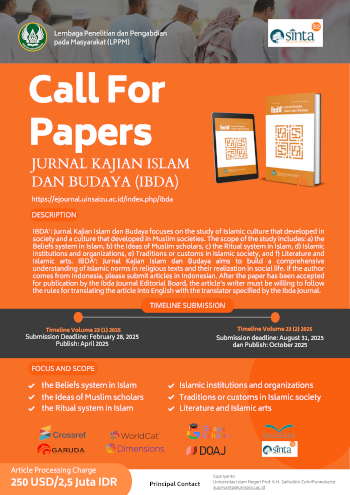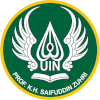Chemical Bonding and Local Islamic Wisdom of Sasak Tribe, Lombok, West Nusa Tenggara
DOI:
https://doi.org/10.24090/ibda.v16i1.1389Keywords:
Chemical bonding theory, local Islamic wisdom, asak tribe LombokAbstract
A myriad of traditions underlie the local wisdom of Sasak tribe (the indigenous people in Lombok), namely tradisi merarik (wedding), nenarih (proposing), sorong serah ajikrame (dowry negotiation), langar, begawe (party) , banjar (the community body), begibung (eating together), berayan mangan (eating together), and nyongkolan (wedding parade). Such local customs in general entail the value of mutual concession or tolerance, compassion, dependency, social solidarity, sympathy, communal work for peace, and prosperity. The local wisdoms are strongly relevant to the theory of chemical bonding such as electrostatic stability and configuration, the positive and negative ions, theory of chemical bond formation, polar and nonpolar covalent, coordinate covalent bond, metal bonding, and intermolecular forces comprising hydrogen and Van der Waals bond. The interface and relevance of both are actualized in the religious and social values of Sasak Lombok tradition equivalent to the theory of chemical bonding. Therefore, this paper demonstrates that the theory of chemical bonding is strongly relevantly associated with the tradition of local Islamic wisdom of Sasak Lombok, West Nusa Tenggara.Downloads
Download data is not yet available.
References
Achmad and Tupamahu, M.S. 2001. Struktur Atom, Struktur Molekul, dan Sistem Periodik. Bandung: PT. Citra Aditya Bakti.
Al-Azmeh, Aziz [ed.]. 1998. Islamic Law: Social and Historical Contexts. tp.
Alisyahbana. 1996. Indonesia: Social and Cultural Revolution. Oxford University Press.
Anonim. 1994. Sejarah Daerah Nusa Tenggara Barat. Mataram: Depdikbud.
Anonim. 1997. Adat Istiadat Daerah Nusa Tenggara Barat. Mataram: Depdikbud.
Baum, S. J., and Scaife, C. W. J. 1980. Chemistry, A Life Science Approach Second Edition. New York: Macmillan Publishing.
Budiwanti, Erni. 2000. Islam Sasak. Yogyakarta: LKiS Yogyakarta.
Chang, Raymond. 2004. Kimia Dasar (Konsep-Konsep Inti Edisi Ketiga Jilid 1) . Jakarta: Erlangga.
Habibi. 2014. Kearifan Lokal Sasak dalam Menjawab Modernisasi.
Ismail, M, Sukardi, and Su’ud Surachman, 2009. “Pengembangan Model Pembelajaran IPS Berbasis Kearifan Lokal Masyarakat Sasak: Kearah Sikap dan Berprilaku Berdemokrasi Siswa SMP/MTs†dalam Jurnal Pendidikan dan Pengajaran, Jilid 42, Nomor 2, Juli 2009. Singaraja: Undiksha.
Jasmansyah. 2014. Tradisi Merarik (Menikah) dalam Adat Sasak Lombok Dalam Perspektif Gender .
Juhaepa and Sarpin, Fungsi Banjar dalam Suku Sasak Terhadap Solidaritas Sosial, dalam Jurnal Pemikiran dan Penelitian Sosiologi, Vol.1. No.1, Edisi April 2014. Kendari: Universitas Halu Oleo.
Kluckhohn dalam Universal Catagories of Culture, 1953.
Koentjaraningrat. 2009. Pengantar Ilmu Antropologi. Jakarta: Rineka Cipta.
Miessler, G. L., and Tarr, D. A. 1999. Inorganic Chemistry. Second Edition. New Jersey: Prentice Hall International.
Prasetiawan,Widi. 2009. Kimia Dasar 1. Jakarta: Cerdas Pustaka.
Saito, Taro. 1996. Kimia Anorganik. (Diterj. Ismunandar). Tokyo: Iwanami Shoten Publishers.
Salam, Solichin. 1992. Lombok Pulau Perawan. Jakarta: Kuning Mas.
Siregar, Morgong. 1988. Dasar-dasar Kimia Organik . Jakarta: P2LPTK.
Staff, Nell F. 1995. Kamus Sasak Indonesa Inggris. Mataram: University Mataram Press.
Sukardjo. 1990. Ikatan Kimia. Yogyakarta: Rineka Cipta.
Wilbraham, C. Antony and Matta, S. Michael. 1992. Pengantar Kimia Organik dan Hayati . Bandung: ITB.
Zakaria, Fath. 1998. Mozaik Budaya Orang Mataram. Mataram: Yayasan Sumurnas Al Hamidy.
Al-Azmeh, Aziz [ed.]. 1998. Islamic Law: Social and Historical Contexts. tp.
Alisyahbana. 1996. Indonesia: Social and Cultural Revolution. Oxford University Press.
Anonim. 1994. Sejarah Daerah Nusa Tenggara Barat. Mataram: Depdikbud.
Anonim. 1997. Adat Istiadat Daerah Nusa Tenggara Barat. Mataram: Depdikbud.
Baum, S. J., and Scaife, C. W. J. 1980. Chemistry, A Life Science Approach Second Edition. New York: Macmillan Publishing.
Budiwanti, Erni. 2000. Islam Sasak. Yogyakarta: LKiS Yogyakarta.
Chang, Raymond. 2004. Kimia Dasar (Konsep-Konsep Inti Edisi Ketiga Jilid 1) . Jakarta: Erlangga.
Habibi. 2014. Kearifan Lokal Sasak dalam Menjawab Modernisasi.
Ismail, M, Sukardi, and Su’ud Surachman, 2009. “Pengembangan Model Pembelajaran IPS Berbasis Kearifan Lokal Masyarakat Sasak: Kearah Sikap dan Berprilaku Berdemokrasi Siswa SMP/MTs†dalam Jurnal Pendidikan dan Pengajaran, Jilid 42, Nomor 2, Juli 2009. Singaraja: Undiksha.
Jasmansyah. 2014. Tradisi Merarik (Menikah) dalam Adat Sasak Lombok Dalam Perspektif Gender .
Juhaepa and Sarpin, Fungsi Banjar dalam Suku Sasak Terhadap Solidaritas Sosial, dalam Jurnal Pemikiran dan Penelitian Sosiologi, Vol.1. No.1, Edisi April 2014. Kendari: Universitas Halu Oleo.
Kluckhohn dalam Universal Catagories of Culture, 1953.
Koentjaraningrat. 2009. Pengantar Ilmu Antropologi. Jakarta: Rineka Cipta.
Miessler, G. L., and Tarr, D. A. 1999. Inorganic Chemistry. Second Edition. New Jersey: Prentice Hall International.
Prasetiawan,Widi. 2009. Kimia Dasar 1. Jakarta: Cerdas Pustaka.
Saito, Taro. 1996. Kimia Anorganik. (Diterj. Ismunandar). Tokyo: Iwanami Shoten Publishers.
Salam, Solichin. 1992. Lombok Pulau Perawan. Jakarta: Kuning Mas.
Siregar, Morgong. 1988. Dasar-dasar Kimia Organik . Jakarta: P2LPTK.
Staff, Nell F. 1995. Kamus Sasak Indonesa Inggris. Mataram: University Mataram Press.
Sukardjo. 1990. Ikatan Kimia. Yogyakarta: Rineka Cipta.
Wilbraham, C. Antony and Matta, S. Michael. 1992. Pengantar Kimia Organik dan Hayati . Bandung: ITB.
Zakaria, Fath. 1998. Mozaik Budaya Orang Mataram. Mataram: Yayasan Sumurnas Al Hamidy.

Downloads
Published
2018-05-10
How to Cite
Fadli, A. (2018). Chemical Bonding and Local Islamic Wisdom of Sasak Tribe, Lombok, West Nusa Tenggara. IBDA` : Jurnal Kajian Islam Dan Budaya, 16(1). https://doi.org/10.24090/ibda.v16i1.1389
Issue
Section
Articles
License
Authors who publish with this journal agree to the following terms:
- Authors retain copyright and grant the journal right of first publication with the work simultaneously licensed under a Creative Commons Attribution-ShareAlike License a that allows others to share the work with an acknowledgement of the work's authorship and initial publication in this journal.
- Authors are able to enter into separate, additional contractual arrangements for the non-exclusive distribution of the journal's published version of the work (e.g., post it to an institutional repository or publish it in a book), with an acknowledgment of its initial publication in this journal.
- Authors are permitted and encouraged to post their work online (e.g., in institutional repositories or on their website) before and during the submission process, as it can lead to productive exchanges, as well as earlier and greater citation of published work (See The Effect of Open Access).















